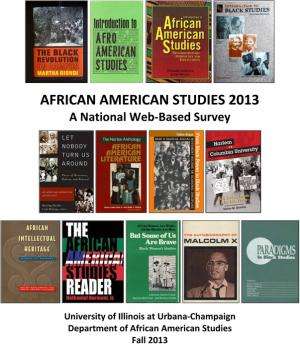More than three-quarters of U.S. colleges and universities in a survey offer black studies in some form, says a new report from the African American studies department at the U. of I. Credit: Provided
The field of African American studies in U.S. higher education "is alive and well, and, in fact, growing and maturing," despite some reports to the contrary, says a new study published online this week by the department of African American studies at the University of Illinois.
Through a national Web-based survey of 1,777 U.S. colleges and universities, U. of I. researchers found that 76 percent of those institutions had some form of black studies.
Twenty percent, or 361 institutions, had formal academic units, most classified as departments or programs, according to the study. But another 56 percent, or 999 institutions, had a course or courses dedicated to the black experience.
This positive assessment conflicts with many studies in recent years – and news reports based on those studies – which have suggested that black studies programs are disappearing, according to Ronald Bailey, the head of the department of African American studies at Illinois. But many of those studies were based on a small, selective sampling, he said.
Those studies "are more like biopsies," according to the report, "and what the field needs is this kind of broad survey with data that can be generalized. We need to understand the forest, and not just a few trees, no matter how tall and prestigious they might be."
Abdul Alkalimat, a professor in the department of African American studies and in the Graduate School of Library and Information Studies at the U. of I., was the lead author of the report, titled "African American Studies 2013: A National Web-Based Survey."
The report, Alkalimat said, "grows out of a long-term interest in producing scholarship focused on understanding how black studies is actually being practiced across the U.S." It should be of interest to a broad array of scholars and administrators in higher education, he said.
Co-authors of the report were Bailey; Sam Byndom, Desiree McMillion and LaTasha Nesbitt, all doctoral students in the department of education policy, organization and leadership; Kate Williams, a professor in GSLIS; and Brian Zelip, a master's degree student in GSLIS.
The researchers did "data collection on a shoestring," according to the report, by drawing on websites to gather the colleges' and universities' own self-reported data.
Among other findings, the researchers found that more than a third, or 35 percent, of all formal African American studies units are classified as departments, which are considered more permanent in the institution and its budget. Of the rest, 57 percent are classified as programs and eight percent as some other kind of unit.
Looking at regions of the country, the researchers found that institutions in the South were the most likely to have black studies in some form, at 87 percent, even though only 16 percent had units. On the other hand, institutions in the West were the least likely to have black studies in some form, at 56 percent, even though 23 percent had units.
The same figures for the Midwest were 79 percent and 22 percent, and for the Northeast 74 percent and 23 percent.
The researchers found that nearly half of all black studies units, or 49 percent, use terms in their unit names such as "Africana," "African and African American," or "Pan-African" that reflect the larger African diaspora or the different waves of Africa-descended peoples who have come to the U.S. The highest percentage was in the Northeast, at 65 percent, which the researchers suggested might be due to recent immigration into those states. "National" names – including African American, Afro-American or Black – are used by 32 percent of all programs.
They also found that 46 percent of black studies unit heads were women, showing that these units "have been as successful as any in higher education in recognizing and promoting gender equity in their leadership," Bailey said.
In addition, the researchers found that 53 percent of units were located on campuses that also had Latino studies units. Bailey described this finding as "essential," given changing demographics and the need to build coalitions between blacks and Latinos in the larger society.
Gauging the state of black studies in its broad, historical context is important, Bailey said, because its influence has often gone beyond its size.
"Many people assume that black studies was simply a political response to the turmoil of the 1960s," Bailey said. "What is not fully appreciated is that black studies also spurred and inspired many significant transformations in higher education. For instance, it produced one of the first big discussions of interdisciplinary scholarship, and of what is now known as service learning. It is a discipline and field connected by countless threads to communities and to other disciplines and arenas of scholarship in higher education, both in the U.S. and around the world."
More information: www.afro.illinois.edu/document … ackStudiesSurvey.pdf
Provided by University of Illinois at Urbana-Champaign





















